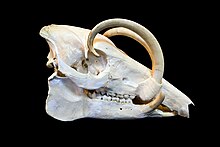| North Sulawesi babirusa | |
|---|---|

| |
| Adult male | |

| |
| Scientific classification | |
| Domain: | Eukaryota |
| Kingdom: | Animalia |
| Phylum: | Chordata |
| Class: | Mammalia |
| Order: | Artiodactyla |
| Family: | Suidae |
| Genus: | Babyrousa |
| Species: | B. celebensis
|
| Binomial name | |
| Babyrousa celebensis Deninger, 1909
| |

| |
The North Sulawesi babirusa (Babyrousa celebensis) is a pig-like animal native to Sulawesi and some nearby islands (Lembeh, Buton and Muna) in Indonesia.[3] It has two pairs of large tusks composed of enlarged canine teeth. The upper canines penetrate the top of the snout, curving back toward the forehead. The North Sulawesi babirusa is threatened from hunting and deforestation.[1]
The common and scientific names are various transcriptions of its local name, which literally translated means "pig-deer" (from Indonesian babi, "pig" + rusa, "deer"[4] – see also Javan rusa) in reference to the huge tusks of the male suggestive of a deer's antlers.
- ^ a b Leus, K.; Macdonald, A.; Burton, J.; Rejeki, I. (2016). "Babyrousa celebensis". IUCN Red List of Threatened Species. 2016: e.T136446A44142964. doi:10.2305/IUCN.UK.2016-1.RLTS.T136446A44142964.en. Retrieved 19 November 2021.
- ^ "Appendices | CITES". cites.org. Retrieved 2022-01-14.
- ^ Grubb, P. (2005). "Order Artiodactyla". In Wilson, D.E.; Reeder, D.M (eds.). Mammal Species of the World: A Taxonomic and Geographic Reference (3rd ed.). Johns Hopkins University Press. p. 637. ISBN 978-0-8018-8221-0. OCLC 62265494.
- ^ "Babirusa | Definition of Babirusa by Merriam-Webster". Merriam-webster.com. Retrieved 2017-05-13.
